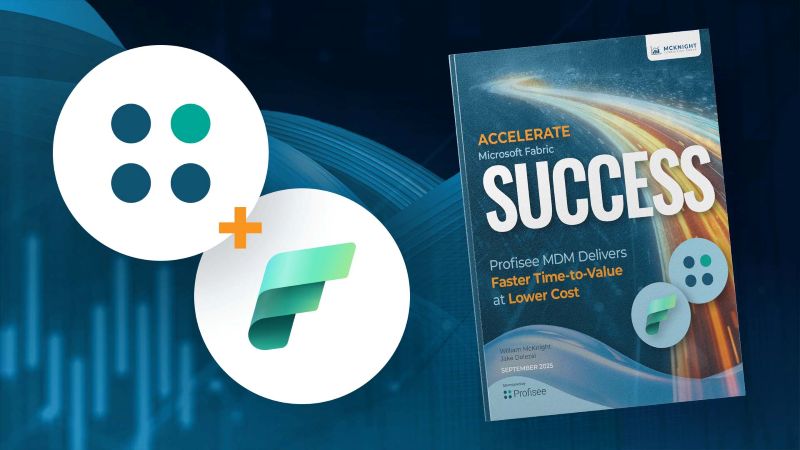If you missed the live stream of our inaugural “Data After Dark” series, we’ve highlighted a few of the key takeaways in part 1 of our two-part recap.
Here in part 2, we expand on how you can use MDM to unlock the power of Microsoft Azure and explain a few of the implementation options for MDM. To get the full experience and hear all the insights from our expert panel, be sure to watch a recording of the event.
Profisee’s Chief Technology Officer, Eric Melcher, said while many data professionals may not understand at first how MDM could fit into their data estate, that it helps to frame the discussion in terms of specific, real-world business challenges and breaking them down into manageable pieces.
Continuing with the customer domain example, Eric said a customer may initially take on too large of a project or dataset initially, saying “We’re going to create the best customer master that we can.” This can lead down an expensive, time-consuming path of trying to manually match all the dimensions of customer data rather than starting from a real business challenge and creating a trusted Golden Record that can be used by downstream applications..
“[Customers] wind up investing so much time getting the data right in general rather than narrowing the scope and focusing on a slice of customer data that can be put through the MDM process,” Eric said. “[MDM then] produces a list of clean, trusted customer accounts that you can reach out to and upsell additional products to without the risk or concern of the end customers saying, ‘Don’t you know I already have that product from your company?’”
Eric has been in the tech industry for nearly 15 years working in data warehousing, consulting, and working in the field directly with Profisee customers. Eric is now focused on product strategy & roadmap, engineering, Q & A, and support at Profisee.
MDM Configuration: On-premises vs. In the Cloud
The Profisee Platform is built on a modern, Platform as a Service (PaaS) cloud architecture that can take advantage of the scalability and lower cost of cloud deployment while enabling the critical flexibility required by the data model as well as seamless data access for a multi-domain MDM solution. Profisee’s cloud-native architectures are built for Azure and have the industry’s first and only containerized PaaS MDM solution for Azure. But MDM can be deployed in a variety of ways, and Eric suggested during “Data After Dark” that customers should think of their MDM implementation as a function of where their source data lives today.
“You want to really understand your company, where your data exists today and your future strategy so that the MDM vendor and tool you select can migrate with you as you change over time,” Eric said.
Profisee is as easy to deploy as a Microsoft app using the Azure Resource Manager (ARM) template, so customers using the Microsoft tech stack can also enjoy seamless, native integration with Azure Data Factory, Azure Data Catalog and more.
James at Microsoft also shared the importance of looking to qualified partners to fill in any gaps in the Azure data estate.
“In the Microsoft ecosystem, we often look to partners to fill any gaps we have in our solution offering for customers,” James said. “I’ve worked with Profisee for a number of years and feel comfortable doing so because there is a strategic relationship with Microsoft. And we know the technologies integrate [with] my years of proven customer success implementing Profisee.”
“I’ve worked with Profisee for a number of years and feel comfortable doing so because there is a strategic relationship with Microsoft. And we know the technologies integrate [with] my years of proven customer success implementing Profisee.”
— James Serra, Data Warehouse Evangelist at Microsoft
Though Profisee enjoys a longstanding alignment with Microsoft, the Profisee Platform was built to support a containerized deployment which means we are cloud-agnostic and support PaaS (Platform-as-a-Service) on Amazon Web Services (AWS), Google Cloud Services (GCS), as well as Azure.
Mastering Multiple Domains
Our panel of MDM experts closed Data After Dark with a quick discussion of multi-domain MDM and how that fits into a marketplace where some MDM vendors are focused on single-domain solutions like Customer 360 or Product 360.
James shared that has concerns about limiting your MDM implementation to a single domain.
“While [having separate entities across a data mesh] sounds great in theory, the challenge is… [trying to] pull it all together when somebody needs information from all these different entities, not just one,” James said. “I’m still of the belief that it’s better to centralize everything because you can then [have one team] in charge of cleaning it and mastering it.”
Neal Danner, Chief Technology Officer at Quest Analytics, also emphasized that the point and purpose of MDM is to provide an understanding and global view of the domain you are studying. Even though that data may be used by multiple departments internally for different purposes, they are all working from one trusted set of clean data.
Learn More About Common Pitfalls to Avoid in the Full Recording of ‘Data After Dark’
Our Data After Dark session included a panel of experienced MDM experts who discussed master data management from their different perspectives: Neal, a customer implementer; James, a Microsoft data technologist; and Eric with the MDM vendor.
We covered:
- How and why to use Master Data Management
- The role of MDM in a typical Microsoft Azure implementation
- Common implementation scenarios and common pitfalls (to avoid!)
For more expert insights — including common pitfalls to avoid when implementing MDM — watch a recording of the event, read part 1 of our recap and keep an eye out for future Profisee webinars and events.
Cheers to informative data chats — until meet again!

Martin Boyd
Martin Boyd is the VP of Product Marketing at Profisee and has over 15 years of experience in MDM, data governance and data quality.











